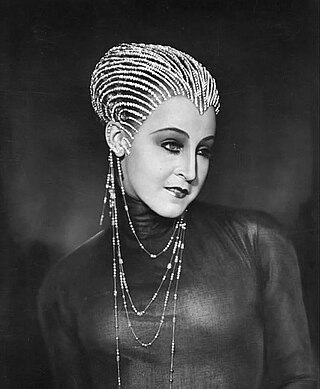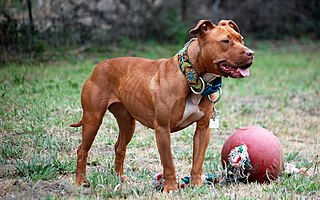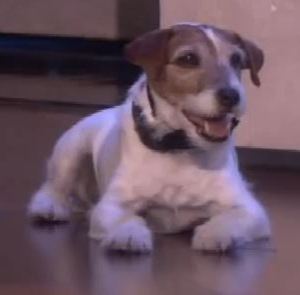Related Research Articles

The German Shepherd, also known in Britain as an Alsatian, is a German breed of working dog of medium to large size. The breed was developed by Max von Stephanitz using various traditional German herding dogs from 1899.

Brigitte Helm was a German actress, best remembered for her dual role as Maria and her double named Futura, in Fritz Lang's 1927 silent film, Metropolis.

In March 1944, Hungary was invaded and occupied by the Wehrmacht. This invasion was formally known as Operation Margarethe.

The Boston Terrier is a breed of dog originating in the United States of America. This "American Gentleman" was accepted in 1893 by the American Kennel Club as a non-sporting breed. Boston Terriers are small and compact with a short tail and erect ears.

The American Pit Bull Terrier (APBT) is a dog breed recognized by the United Kennel Club (UKC) and the American Dog Breeders Association (ADBA), but not the American Kennel Club (AKC). It is a medium-sized, short-haired dog, of a solid build, whose early ancestors came from England. When compared with the English Staffordshire Bull Terrier, the American Pit Bull Terrier is larger by margins of 6–8 inches (15–20 cm) in height and 25–35 pounds (11–16 kg) in weight. The American Pit Bull Terrier varies in size: males are normally about 18–21 inches (45–53 cm) in height and around 35–60 pounds (15–27 kg) in weight, while females are normally around 17–20 inches (43–50 cm) in height and 30–50 pounds (13–22 kg) in weight.

Hans von Tschammer und Osten was a German sport official, SA leader and a member of the Reichstag for the Nazi Party of Nazi Germany. He was married to Sophie Margarethe von Carlowitz.

Blondi was Adolf Hitler's German Shepherd, a gift as a puppy from Martin Bormann in 1941. Hitler kept Blondi even after his move into the Führerbunker located underneath the garden of the Reich Chancellery on 16 January 1945.

Krypto the Superdog is an American animated television series produced by Warner Bros. Animation, based on Superman's canine companion Krypto, which premiered on Cartoon Network on March 25, 2005, and aired on The CW's Saturday morning block Kids' WB from September 23, 2006, until September 15, 2007. 39 episodes were produced.
Canine reproduction is the process of sexual reproduction in domestic dogs, wolves, coyotes and other canine species.
The Moscow Water Dog, also known as the Moscow Diver, Moscow Retriever or Moskovsky Vodolaz, was a little-known dog breed derived from the Newfoundland, Caucasian Shepherd Dog and East European Shepherd. It is now extinct, but was used in the development of the Black Russian Terrier. The Moscow Water Dog was produced only by the Red Star Kennels, the state-operated organization chartered to provide working dogs for the armed services of the Soviet Union. The breeding program was discontinued as the dogs would attack drowning victims instead of saving them.

Eva Anna Paula Hitler was a German photographer who was the longtime companion and briefly the wife of Adolf Hitler. Braun met Hitler in Munich when she was a 17-year-old assistant and model for his personal photographer, Heinrich Hoffmann. She began seeing Hitler often about two years later.
Canine epileptoid cramping syndrome (CECS), previously known as Spike's Disease, is a hereditary dog disease initially found in Border Terriers and has since been documented in many other dog breeds including Labrador Retrievers and Chihuahuas, with similarities to canine epilepsy. Its cause is unknown. In 2015, a study concluded: "Canine epileptoid cramping syndrome in Border Terrier's is a gluten-sensitive movement disorder triggered and perpetuated by gluten and thus responsive to a gluten-free diet."
A talking animal or speaking animal is any non-human animal that can produce sounds or gestures resembling those of a human language. Several species or groups of animals have developed forms of communication which superficially resemble verbal language, however, these usually are not considered a language because they lack one or more of the defining characteristics, e.g. grammar, syntax, recursion, and displacement. Researchers have been successful in teaching some animals to make gestures similar to sign language, although whether this should be considered a language has been disputed.

Edda Carin Wilhelmine Göring was the only child of German politician, military leader, and leading member of the Nazi Party Hermann Göring, by his second marriage to the German actress Emmy Sonnemann.
Jan Bondeson is a Swedish-British rheumatologist, scientist and author, working as a senior lecturer and consultant rheumatologist at the Cardiff University School of Medicine. He has also written non-fiction on topics such as medical anomalies and unsolved murders. In 2003 he told an interviewer, "I've always had a profound interest in history, especially the history of medicine, and a bit of a fancy for the macabre and odd." Bondeson is the biographer of a predecessor of Jack the Ripper, the London Monster, who stabbed 50 women in the buttocks, of Edward "the Boy" Jones, who stalked Queen Victoria and stole her underwear, and Greyfriars Bobby, a Scottish terrier who supposedly spent 14 years guarding his master's grave.
Rolf was an Airedale terrier that was claimed to have been able to perform arithmetic and communicate with humans on an intellectual level.

Uggie was a trained Parson Russell Terrier famous for his roles in Water for Elephants and The Artist. His memoir Uggie, My Story was published in the United States, the UK, and France in October 2012.
Margot Wölk was a German secretary who was among 15 young women who, in 1942, were selected to taste German leader Adolf Hitler's food at the Wolf's Lair in East Prussia for two-and-a-half years to confirm that it was safe. She was the only one of the 15 to survive World War II, and her background as Hitler's food taster was not revealed until a newspaper interview on her 95th birthday in December 2012.
Joseph Maria Casimir Konrad Michael Benedictus Maurus Placidus Freiherr von und zu Franckenstein was Austro-German philologist, dissident and later US Army Lieutenant attached to the OSS and to the Austrian 'O5' resistance movement against the Nazi Regime.
References
- 1 2 3 4 Thomas Spanier, "Hunde-Grete aus Leutenberg macht Karriere in England," Thüringer Allgemeine , May 28, 2011 (in German)
- 1 2 3 Amu, Titus (May 25, 2011). "Sitz Heil!". sueddeutsche.de (in German). Süddeutsche Zeitung . Retrieved November 8, 2017.
- 1 2 3 4 Thomas Spanier, "Die Hundeflüsterer von Leutenberg," Thüringer Allgemeine, June 4, 2011 (in German)
- 1 2 3 Thomas Spanier, "Augenzeuge hegt Zweifel an sprechenden Hunden in Leutenberg," Ostthüringer Zeitung, May 31, 2011 (in German)
- ↑ Britt von den Berg, Die "Neue Tierpsychologie" und ihre wissenschaftlichen Vertreter (von 1900 bis 1945), dissertation, Tierärztliche Hochschule Hannover, Berlin/Bristol: Tenea, 2008, ISBN 978-3-86504-258-3, pp. 124–25, pdf pp. 130–31 (in German)
- ↑ von den Berg, p. 125, pdf p. 131.
- 1 2 3 4 Bondeson, Jan (2011). Amazing Dogs: A Cabinet of Canine Curiosities. Ithaca, New York: Cornell University. ISBN 978-0-8014-5017-4.
- 1 2 3 4 5 "Nazis tried to train dogs to talk, read and spell to win WW2," The Daily Telegraph May 24, 2011
- 1 2 Michael Sheridan, "Adolf Hitler's Nazi scientists sought to teach dogs to talk, read, write: book,", New York Daily News , May 26, 2011, retrieved February 7, 2012.
- 1 2 Simon de Bruxelles, The Times , "Nazis bred 'talking' dogs for war effort," The Australian , May 26, 2011, retrieved February 7, 2012.
- ↑ William Lee Adams, "How Nazi Scientists Tried to Create an Army of Talking Dogs," Time , May 25, 2011, retrieved February 7, 2012.
- ↑ Stanley Coren, "The School to Teach Nazi War Dogs to Speak: Hitler wanted dogs that could communicate with their SS masters," Canine Corner, Psychology Today , May 26, 2011.
- ↑ Maureen Dowd, "Hitler’s Talking Dogs," The New York Times , July 12, 2011, retrieved February 7, 2012.
- 1 2 "Author Jan Bondeson frowns on 'Nazi Superdog' claims: An academic believes "Nazi superdog" press coverage has trivialised his study of the history of the partnership between man and his canine best friend," BBC News Wales, May 28, 2011.